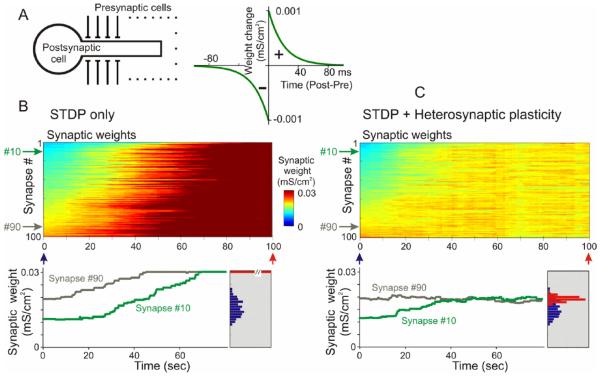Figure 4.
Heterosynaptic plasticity prevents runaway dynamics of synaptic weights. (A) A scheme of a model neuron and STDP learning rule. The model neuron consisted of axosomatic and dendritic compartments, receiving 100 synaptic inputs from 100 presynaptic neurons. Each presynaptic neuron fired action potentials at ~1 Hz, with Poisson distributed interspike intervals. In simulations shown in this figure, firing of input neurons was mildly correlated (averaged cross-correlation 0.35 ± 0.05), and STDP learning rule had symmetrical potentiation and depression windows. (B) In a model with symmetrical STDP learning rule (τ+ = τ− = 20 ms; a+ = a− = 0.001 mS/cm2) synaptic inputs express runaway dynamics, and saturate at maximal value. Color plot shows dynamics of changes of synaptic weights (color coded). Synapses were sorted by their weights at the beginning of experiment. Bottom: Time course of weight changes of synapses #10 and #90. Inset on the right shows distributions of synaptic weights at the beginning (red) and at the end of the simulation. At the end of the simulation, all inputs were potentiated to the maximum (red bar length is out of scale). (C) In a model with STDP and heterosynaptic plasticity implemented according to experimental data, same pattern of input activity did not lead to saturation of synaptic weights. Instead, synaptic weights reached a new balance and formed a normal distribution around a new mean. Conventions as in B (Modified, with permission, from Chen and others 2013b).

